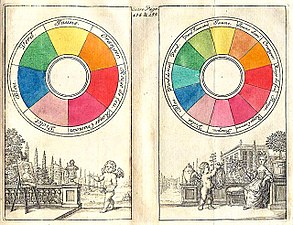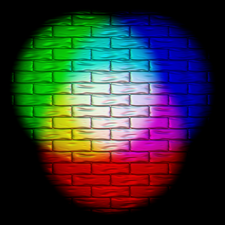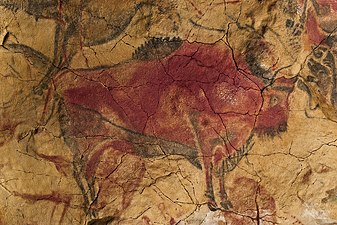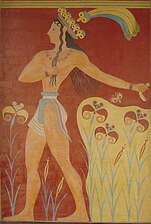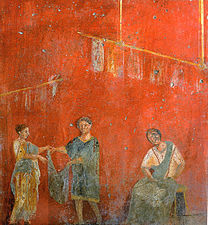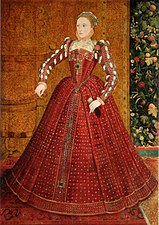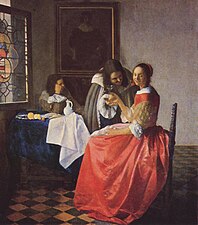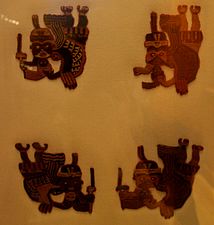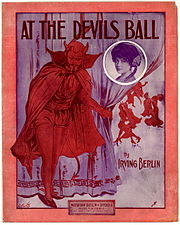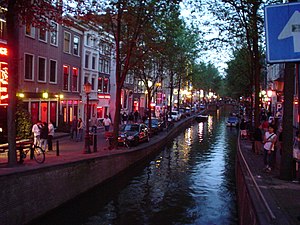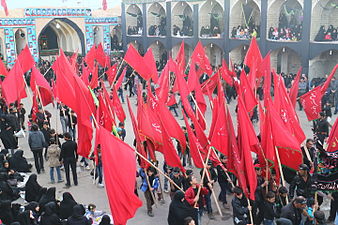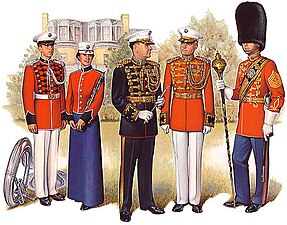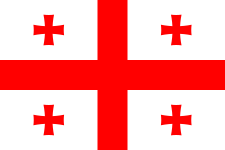Red
| Red | |
|---|---|
| Source | X11 |
| B: Normalized to [0–255] (byte) H: Normalized to [0–100] (hundred) | |
Red is the color at the long wavelength end of the
Red pigment made from
Since red is the color of blood, it has historically been associated with sacrifice, danger, and courage. Modern surveys in Europe and the United States show red is also the color most commonly associated with heat, activity, passion, sexuality, anger, love, and joy. In China, India, and many other Asian countries it is the color symbolizing happiness and good fortune.[4]: 39–63
Shades and variations
Varieties of the color red may differ in
In science and nature
Seeing red

The human eye sees red when it looks at light with a wavelength between approximately 625 and 740 nanometers.[1] It is a primary color in the RGB color model and the light just past this range is called infrared, or below red, and cannot be seen by human eyes, although it can be sensed as heat.[7] In the language of optics, red is the color evoked by light that stimulates neither the S or the M (short and medium wavelength) cone cells of the retina, combined with a fading stimulation of the L (long-wavelength) cone cells.[8]
Primates can distinguish the full range of the colors of the spectrum visible to humans, but many kinds of mammals, such as dogs and cattle, have dichromacy, which means they can see blues and yellows, but cannot distinguish red and green (both are seen as gray). Bulls, for instance, cannot see the red color of the cape of a bullfighter, but they are agitated by its movement.[9] (See color vision).
One theory for why primates developed sensitivity to red is that it allowed ripe fruit to be distinguished from unripe fruit and inedible vegetation.[10] This may have driven further adaptations by species taking advantage of this new ability, such as the emergence of red faces.[11]
Red light is used to help adapt night vision in low-light or night time, as the rod cells in the human eye are not sensitive to red.[12][13]
In color theory and on a computer screen
In the
In the CMY and CMYK color models, red is a secondary color subtractively mixed from magenta and yellow.[citation needed]
In the
-
In a traditional color wheel from 1708, red, yellow and blue are primary colors. Red and yellow make orange; red and blue make violet.
-
In modern color theory, red, green and blue are the additive primary colors, and together they make white. A combination of red, green and blue light in varying proportions makes all the colors on your computer screen and television screen.
-
Tiny Red, green and bluesub-pixels(enlarged on left side of image) create the colors you see on your computer screen and TV.
Color of sunset

As a ray of white sunlight travels through the atmosphere to the eye, some of the colors are scattered out of the beam by air molecules and
Lasers
Red's wavelength has been an important factor in laser technologies; red lasers, used in early compact disc technologies, are being replaced by blue lasers, as red's longer wavelength causes the laser's recordings to take up more space on the disc than would blue-laser recordings.[21]
Astronomy
- Mars is called the Red Planet because of the reddish color imparted to its surface by the abundant iron oxide present there.[22]
- Astronomical objects that are moving away from the observer exhibit a Doppler red shift.
- Jupiter's surface displays a Great Red Spot caused by an oval-shaped mega storm south of the planet's equator.[23]
- thermonuclear fusion of hydrogen in a shell that surrounds its core. They have radii tens to hundreds of times larger than that of the Sun. However, their outer envelope is much lower in temperature, giving them an orange hue. Despite the lower energy density of their envelope, red giants are many times more luminous than the Sun due to their large size.
- Red supergiants like Betelgeuse, Antares, Mu Cephei, VV Cephei, and VY Canis Majoris one of the biggest stars in the Universe, are the biggest variety of red giants. They are huge in size, with radii 200 to 1700 times greater than the Sun, but relatively cool in temperature (3000–4500 K), causing their distinct red tint. Because they are shrinking rapidly in size, they are surrounded by an envelope or skin much bigger than the star itself. The envelope of Betelgeuse is 250 times bigger than the star inside.
- A red dwarf is a small and relatively cool star, which has a mass of less than half that of the Sun and a surface temperature of less than 4,000 K. Red dwarfs are by far the most common type of star in the Galaxy, but due to their low luminosity, from Earth, none are visible to the naked eye.[24]
- Interstellar reddeningis caused by the extinction of radiation by dust and gas
-
Mars appears to be red because of iron oxide on its surface.
-
Artist's impression of a red dwarf, a small, relatively cool star that appears red due to its temperature
Pigments and dyes
-
Red ochre cliffs near Roussillon in France. Red ochre is composed of clay tinted with hematite. Ochre was the first pigment used by man in prehistoric cave paintings.
-
Vermilion pigment, made from cinnabar. This was the pigment used in the murals of Pompeii and to color Chinese lacquerware beginning in the Song dynasty.
-
lead tetroxide. The Romans prepared it by the roasting of lead white pigment. It was commonly used in the Middle Ages for the headings and decoration of illuminated manuscripts.
-
The roots of the Rubia tinctorum, or madder plant, produced the most common red dye used from ancient times until the 19th century.
-
Alizarin was the first synthetic red dye, created by German chemists in 1868. It duplicated the colorant in the madder plant, but was cheaper and longer lasting. After its introduction, the production of natural dyes from the madder plant virtually ceased.
Food coloring
The most common synthetic food coloring today is Allura Red AC, a red azo dye that goes by several names including: Allura Red, Food Red 17, C.I. 16035, FD&C Red 40,[25][26] It was originally manufactured from coal tar, but now is mostly made from petroleum.[27]
In Europe, Allura Red AC is not recommended for consumption by children. It is banned in Denmark, Belgium, France and Switzerland, and was also banned in Sweden until the country joined the European Union in 1994.[26] The European Union approves Allura Red AC as a food colorant, but EU countries' local laws banning food colorants are preserved.[28]
In the United States, Allura Red AC is approved by the Food and Drug Administration (FDA) for use in cosmetics, drugs, and food. It is used in some tattoo inks and is used in many products, such as soft drinks, children's medications, and cotton candy. On June 30, 2010, the Center for Science in the Public Interest (CSPI) called for the FDA to ban Red 40.[29]
Because of public concerns about possible health risks associated with synthetic dyes, many companies have switched to using natural pigments such as carmine, made from crushing the tiny female cochineal insect. This insect, originating in Mexico and Central America, was used to make the brilliant scarlet dyes of the European Renaissance.[citation needed]
Autumn leaves
This section needs additional citations for verification. (July 2021) |
The red of autumn leaves is produced by pigments called anthocyanins. They are not present in the leaf throughout the growing season, but are actively produced towards the end of summer.[30] They develop in late summer in the sap of the cells of the leaf, and this development is the result of complex interactions of many influences—both inside and outside the plant. Their formation depends on the breakdown of sugars in the presence of bright light as the level of phosphate in the leaf is reduced.[31]
During the summer growing season, phosphate is at a high level. It has a vital role in the breakdown of the sugars manufactured by chlorophyll. But in the fall, phosphate, along with the other chemicals and nutrients, moves out of the leaf into the stem of the plant. When this happens, the sugar-breakdown process changes, leading to the production of anthocyanin pigments. The brighter the light during this period, the greater the production of anthocyanins and the more brilliant the resulting color display. When the days of autumn are bright and cool, and the nights are chilly but not freezing, the brightest colorations usually develop.
Anthocyanins temporarily color the edges of some of the very young leaves as they unfold from the buds in early spring. They also give the familiar color to such common fruits as cranberries, red apples, blueberries, cherries, raspberries, and plums.
Anthocyanins are present in about 10% of tree species in temperate regions, although in certain areas—a
Blood and other reds in nature
This section needs additional citations for verification. (July 2021) |
Oxygenated blood is red due to the presence of oxygenated hemoglobin that contains iron molecules, with the iron components reflecting red light.[32][33] Red meat gets its color from the iron found in the myoglobin and hemoglobin in the muscles and residual blood.[34]
Plants like
-
Red blood cell agar. Blood appears red due to the iron molecules in blood cells.
-
Ared setteror Irish setter
-
A pair of European red foxes
-
The European robin or robin redbreast
Hair color

Red hair occurs naturally on approximately 1–2% of the human population.
Red hair varies from a deep
In animal and human behavior
Red is associated with
History and art
In prehistory and the ancient world
-
Bison in red ochre in the Cave of Altamira, Spain, from upper Paleolithic era (36,000 BC)
-
Roman wall painting showing a dye shop, Pompeii (40 BC)
Inside cave 13B at
Red hematite powder was also found scattered around the remains at a grave site in a Zhoukoudian cave complex near Beijing. The site has evidence of habitation as early as 700,000 years ago. The hematite might have been used to symbolize blood in an offering to the dead.[3]: 4
Red, black and white were the first colors used by artists in the Upper Paleolithic age, probably because natural pigments such as red ochre and iron oxide were readily available where early people lived. Madder, a plant whose root could be made into a red dye, grew widely in Europe, Africa and Asia.[50] The cave of Altamira in Spain has a painting of a bison colored with red ochre that dates to between 15,000 and 16,500 BC.[51]
A red dye called
Red hematite powder was also found scattered around the remains at a grave site in a Zhoukoudian cave complex near Beijing. The site has evidence of habitation as early as 700,000 years ago. The hematite might have been used to symbolize blood in an offering to the dead.[3]: 4
In ancient Egypt, red was associated with life, health, and victory. Egyptians would color themselves with red ochre during celebrations.[54] Egyptian women used red ochre as a cosmetic to redden cheeks and lips[55] and also used henna to color their hair and paint their nails.[56]
The ancient Romans wore
The Romans liked bright colors, and many
The Middle Ages
-
Roman Catholic Popes wear red as the symbol of the blood of Christ. This is Pope Innocent III, in about 1219.
-
Red was the traditional color ofmartyrs. A Russian icon of Saint George(14th c.).
-
The color of majesty - portrait of Charlemagne, King of the Franks and Holy Roman Emperor, Netherlands (14th c.)
After the fall of the Western Roman Empire, red was adopted as a color of majesty and authority by the
In Western Europe, Emperor
In western countries red is a symbol of martyrs and sacrifice, particularly because of its association with blood.: 36
Renaissance
-
The young Queen Elizabeth I (here in about 1563)
-
The Wedding Dance (1566), by Pieter Bruegel the Elder
-
The Girl with the Wine Glass, by Johannes Vermeer (1659–60)
-
Princess Anne of Denmark (later Queen Anne of Great Britain) (1685)
In
In Venice, Titian was the master of fine reds, particularly vermilion; he used many layers of pigment mixed with a semi-transparent glaze, which let the light pass through, to create a more luminous color. The figures of God, the Virgin Mary and two apostles are highlighted by their vermilion red costumes.
Queen Elizabeth I of England liked to wear bright reds, before she adopted the more sober image of the "Virgin Queen".
Red costumes were not limited to the upper classes. In Renaissance Flanders, people of all social classes wore red at celebrations. One such celebration was captured in The Wedding Dance (1566) by Pieter Bruegel the Elder.
The painter Johannes Vermeer skilfully used different shades and tints of vermilion to paint the red skirt in The Girl with the Wine Glass, then glazed it with madder lake to make a more luminous color.
Reds from the New World
-
Feather headdress from theAztec people of Mexico and Central America, dyed with cochineal
-
A native of Central America collecting cochineal insects from a cactus to make red dye (1777)
In Latin America, the
18th to 20th century
-
King Joseph I of Portugal (1773)
-
The Brazilian imperial family (1857)
-
KingEdward VII of the United Kingdom(1901)
-
Red flag of the Bolsheviks, by Boris Kustodiev (1920)
-
Chinesehonour guard, Beijing, 2007
In the 18th century, red began to take on a new identity as the color of resistance and revolution. It was already associated with blood, and with danger; a red flag hoisted before a battle meant that no prisoners would be taken. In 1793-94, red became the color of the French Revolution. A red Phrygian cap, or "liberty cap", was part of the uniform of the sans-culottes, the most militant faction of the revolutionaries.[62]
In the late 18th century, during a strike English dock workers carried red flags, and it thereafter became closely associated with the new labour movement, and later with the Labour Party in the United Kingdom, founded in 1900.
In Paris in 1832, a red flag was carried by working-class demonstrators in the failed
Symbolism
Courage and sacrifice
Surveys show that red is the color most associated with courage.: 36
-
Robert Gibb's 1881 painting, The Thin Red Line, depicting The Thin Red Line at the Battle of Balaclava (1854), when a line of the Scottish Highland infantry repulsed a Russian cavalry charge. The name was given by the British press as a symbol of courage against the odds.
-
The red poppy flower is worn on Remembrance Day in Commonwealth countries to honor soldiers who died in the First World War.
Hatred, anger, aggression, passion, heat and war
While red is the color most associated with love, it also the color most frequently associated with
: 42, 53Warning and danger
Red is the traditional color of warning and danger, and is therefore often used on flags. In the Middle Ages up through the
Several studies have indicated that red carries the strongest reaction of all the colors, with the level of reaction decreasing gradually with the colors orange, yellow, and white, respectively.
Red is the international color of stop signs and stop lights on highways and intersections. It was standardized as the international color at the Vienna Convention on Road Signs and Signals of 1968. It was chosen partly because red is the brightest color in daytime (next to orange), though it is less visible at twilight, when green is the most visible color. Red also stands out more clearly against a cool natural backdrop of blue sky, green trees or gray buildings. But it was mostly chosen as the color for stoplights and stop signs because of its universal association with danger and warning.[4]: 54 The 1968 Vienna Convention on Road Signs and Signals of 1968 uses red color also for the margin of danger warning sign, give way signs and prohibitory signs, following the previous German-type signage (established by Verordnung über Warnungstafeln für den Kraftfahrzeugverkehr in 1927).
-
The standard international stop sign, following the Vienna Convention on Road Signs and Signals of 1968
-
A footballer is shown a red card and ejected from a soccer match.
-
A red Chinese typhoon alert sign
-
Red is the color of a severe terrorist threat level in the United States, under the Homeland Security Advisory System.
-
Red is the color of extreme fire danger in Australia; new black/red stripes are an even more catastrophic hazard.
The color that attracts attention
Red is the color that most attracts attention. Surveys show it is the color most frequently associated with visibility, proximity, and extroverts.[citation needed] It is also the color most associated with dynamism and activity.[4]: 48, 58
Red is used in modern fashion much as it was used in Medieval painting; to attract the eyes of the viewer to the person who is supposed to be the center of attention. People wearing red seem to be closer than those dressed in other colors, even if they are actually the same distance away.[4]: 48, 58 Monarchs, wives of presidential candidates and other celebrities often wear red to be visible from a distance in a crowd. It is also commonly worn by lifeguards and others whose job requires them to be easily found.[74][75]
Because red attracts attention, it is frequently used in advertising, though studies show that people are less likely to read something printed in red because they know it is advertising, and because it is more difficult visually to read than black and white text.[4]: 60
Seduction, sexuality and sin
Red by a large margin is the color most commonly associated with seduction, sexuality, eroticism and immorality, possibly because of its close connection with passion and with danger.[4]: 55
Red was long seen as having a dark side, particularly in Christian theology. It was associated with sexual passion, anger, sin, and the devil.[76][77] In the Old Testament of the Bible, the Book of Isaiah said: "Though your sins be as scarlet, they shall be white as snow."[78] In the New Testament, in the Book of Revelation, the Antichrist appears as a red monster, ridden by a woman dressed in scarlet, known as the Whore of Babylon.[79]
Satan is often depicted as colored red and/or wearing a red costume in both iconography and popular culture.[77][80] By the 20th century, the devil in red had become a folk character in legends and stories. The devil in red appears more often in cartoons and movies than in religious art.[citation needed]
In 17th-century New England, red was associated with
Red is still commonly associated with
In the handkerchief code, the color red signifies interest in the sexual act of fisting.[84]
In both Christian and Hebrew tradition, red is also sometimes associated with murder or guilt, with "having blood on one's hands", or "being caught red-handed.[85]
-
The Whore of Babylon, depicted in a 14th-century French illuminated manuscript. The woman appears attractive, but is wearing red under her blue garment.
-
Reine de joie, (Queen of Joy), a book cover illustration by Henri de Toulouse-Lautrec (1892) about a Paris prostitute
-
Sheet music for "At the Devil's Ball", by Irving Berlin, United States, 1915
-
The red-light district in Amsterdam (2003). Red is the sex industry's preferred color in many cultures, due to being strongly associated with passion, love and sexuality.[4]: 39–63
-
Red lipstick has been worn by women as a cosmetic since ancient times. It was worn by Cleopatra, Queen Elizabeth I, and film stars such as Elizabeth Taylor and Marilyn Monroe.
In religion
- In liturgical color for the feasts of martyrs, representing the blood of those who suffered death for their faith. It is sometimes used as the liturgical color for Holy Week, including Palm Sunday and Good Friday, although this is a modern (20th-century) development. In Catholic practice, it is also the liturgical color used to commemorate the Holy Spirit (for this reason it is worn at Pentecost and during Confirmation masses). Because of its association with martyrdom and the Spirit, it is also the color used to commemorate saints who were martyred, such as St. George and all the Apostles (except for the Apostle St. John, who was not martyred, where white is used). As such, it is used to commemorate bishops, who are the successors of the Apostles (for this reason, when funeral masses are held for bishops, cardinals, or popes, red is used instead of the white that would ordinarily be used).
- In Buddha when he attained enlightenment, or nirvana. It is particularly associated with the benefits of the practice of Buddhism; achievement, wisdom, virtue, fortune and dignity. It was also believed to have the power to resist evil. In China red was commonly used for the walls, pillars, and gates of temples.
- In the Shinto religion of Japan, the gateways of temples, called torii, are traditionally painted vermilion red and black. The torii symbolizes the passage from the profane world to a sacred place. The bridges in the gardens of Japanese temples are also painted red (and usually only temple bridges are red, not bridges in ordinary gardens), since they are also passages to sacred places. Red was also considered a color which could expel evil and disease.
- In Taoism, red is sometimes used to symbolize yang.[86]
- In
-
Cardinals of the Roman Catholic Church at the funeral of PopeJohn Paul II
-
Buddhist monks in Tibet
Military uses
Red uniform
This section needs additional citations for verification. (July 2021) |
The red military uniform was adopted by the English Parliament's
In the modern British army, scarlet is still worn by the
Scarlet is worn for some full dress, military band or mess uniforms in the modern armies of a number of the countries that made up the former British Empire. These include the Australian, Jamaican, New Zealand, Fijian, Canadian, Kenyan, Ghanaian, Indian, Singaporean, Sri Lankan and Pakistani armies.[88]
The musicians of the
Red Serge is the uniform of the Royal Canadian Mounted Police, created in 1873 as the North-West Mounted Police, and given its present name in 1920. The uniform was adapted from the tunic of the British Army. Cadets at the Royal Military College of Canada also wear red dress uniforms.
The Brazilian Marine Corps wears a red dress uniform.
-
Officer and soldier of the British Army, 1815
-
The scarlet uniform of the National Guards Unit of Bulgaria
-
Musicians of theUnited States Marine Corps Band
-
Officer of the Royal Canadian Mounted Police
-
The Brazilian Marine Corps wears a dress uniform called A Garança.
-
Soldiers of the Rajput Regiment of the Indian Army
In sports
This section needs additional citations for verification. (July 2021) |
The first known team sport to feature red uniforms was chariot racing during the late Roman Empire. The earliest races were between two chariots, one driver wearing red, the other white. Later, the number of teams was increased to four, including drivers in light green and sky blue. Twenty-five races were run in a day, with a total of one hundred chariots participating.[90]
Today many sports teams throughout the world feature red on their uniforms. Along with blue, red is the most commonly used non-white color in sports. Numerous national sports teams wear red, often through association with their national flags. A few of these teams feature the color as part of their nickname such as Spain (with their association football (soccer) national team nicknamed La Furia Roja or "The Red Fury") and Belgium (whose football team bears the nickname Rode Duivels or "Red Devils").
In club
The color is commonly used for professional sports teams in Canada and the United States with eleven Major League Baseball teams, eleven National Hockey League teams, seven National Football League teams and eleven National Basketball Association teams prominently featuring some shade of the color. The color is also featured in the league logos of Major League Baseball, the National Football League and the National Basketball Association.[91] In the National Football League, a red flag is thrown by the head coach to challenge a referee's decision during the game. During the 1950s when red was strongly associated with communism in the United States, the modern Cincinnati Reds team was known as the "Redlegs" and the term was used on baseball cards. After the red scare faded, the team was known as the "Reds" again.[92]
In boxing, red is often the color used on a fighter's gloves. George Foreman wore the same red trunks he used during his loss to Muhammad Ali when he defeated Michael Moorer 20 years later to regain the title he lost. Boxers named or nicknamed "red" include Red Burman, Ernie "Red" Lopez, and his brother Danny "Little Red" Lopez.
-
Ancient Roman mosaic of the winner of a chariot race, wearing the colors of the red team
-
Both theCleveland Indians and the Boston Red Soxwear red.
-
In martial arts, a red belt shows a high degree of proficiency, second only, in some schools, to the black belt.
-
AnRosso Corsa("racing red"), the traditional racing color of Italy from the 1920s until the late 1960s.
On flags
This section needs additional citations for verification. (July 2021) |

Red is the most common color found in national flags, found on the flags of 77 percent of the 210 countries listed as independent in 2016; far ahead of white (58 percent); green (40 percent) and blue (37 percent).
The red on the
Red, blue, and white are also the Pan-Slavic colors adopted by the Slavic solidarity movement of the late nineteenth century. Initially these were the colors of the Russian flag; as the Slavic movement grew, they were adopted by other Slavic peoples including Slovaks, Slovenes, and Serbs. The flags of the Czech Republic and Poland use red for historic heraldic reasons (see Coat of arms of Poland and Coat of arms of the Czech Republic) & not due to Pan-Slavic connotations. In 2004 Georgia adopted a new white flag, which consists of four small and one big red cross in the middle touching all four sides.
Red, white, and black were the colors of the German Empire from 1870 to 1918, and as such they came to be associated with German nationalism. In the 1920s they were adopted as the colors of the Nazi flag. In Mein Kampf, Hitler explained that they were "revered colors expressive of our homage to the glorious past." The red part of the flag was also chosen to attract attention – Hitler wrote: "the new flag ... should prove effective as a large poster" because "in hundreds of thousands of cases a really striking emblem may be the first cause of awakening interest in a movement." The red also symbolized the social program of the Nazis, aimed at German workers.[96] Several designs by a number of different authors were considered, but the one adopted in the end was Hitler's personal design.[97]
Red, white, green and black are the colors of Pan-Arabism and are used by many Arab countries.[98]
Red, gold, green, and black are the colors of Pan-Africanism. Several African countries thus use the color on their flags, including South Africa, Ghana, Senegal, Mali, Ethiopia, Togo, Guinea, Benin, and Zimbabwe. The Pan-African colors are borrowed from the flag of Ethiopia, one of the oldest independent African countries.[98][99] Rwanda, notably, removed red from its flag after the Rwandan genocide because of red's association with blood.[100]
The flags of Japan and Bangladesh both have a red circle in the middle of different colored backgrounds. The flag of the Philippines has a red trapezoid on the bottom signifying blood, courage, and valor (also, if the flag is inverted so that the red trapezoid is on top and the blue at the bottom, it indicates a state of war). The flag of Singapore has a red rectangle on the top. The field of the flag of Portugal is green and red. The Ottoman Empire adopted several different red flags during the six centuries of its rule, with the successor Republic of Turkey continuing the 1844 Ottoman flag.
-
The flag of the Byzantine Empire from 1260 to its fall in 1453
-
TheSt George's cross was the banner of the First Crusade, then, beginning in the 13th century, the flag of England. It is the red color (along with that of the Cross of Saint Patrick) in the flag of the United Kingdom, and, by adoption, of the red in the flag of the United States.
-
The red stripes in the flag of the United States were adapted from the flag of the British East India Company. This is the Grand Union Flag, the first U.S. flag established by the Continental Congress.
-
The Flag of Georgia also features the Saint George's Cross. It dates back to the banner of Medieval Georgia in the 5th century.
-
The maple leaf flag of Canada, adopted in 1965. The red color comes from the Saint George's Cross of England.
In politics
This section needs additional citations for verification. (July 2021) |
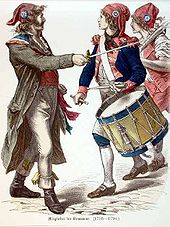
In 18th-century Europe, red was usually associated with the monarchy and with those in power. The
In the Roman Empire, freed slaves were given a red Phrygian cap as an emblem of their liberation. Because of this symbolism, the red "Liberty cap" became a symbol of the American patriots fighting for independence from England. During the French Revolution, the Jacobins also adapted the red Phrygian cap, and forced the deposed King Louis XVI to wear one after his arrest.[101]
Socialism and communism
In the 19th century, with the
In the 20th century, red was the color first of the Russian
Red also became the color of many social democratic parties in Europe, including the Labour Party in Britain (founded 1900); the Social Democratic Party of Germany (whose roots went back to 1863) and the French Socialist Party, which dated back under different names, to 1879. The Socialist Party of America (1901–72) and the Communist Party USA (1919) both also chose red as their color.
Members of the Christian-Social People's Party in Liechtenstein (founded 1918) advocated an expansion of democracy and progressive social policies, and were often referred to disparagingly as "Reds" for their social liberal leanings and party colors.[102]
The Chinese Communist Party, founded in 1920, adopted the red flag and hammer and sickle emblem of the Soviet Union, which became the national symbols when the Party took power in China in 1949. Under Party leader Mao Zedong, the Party anthem became "The East Is Red",[103] and Mao Zedong himself was sometimes referred to as a "red sun".[104] During the Cultural Revolution in China, Party ideology was enforced by the Red Guards, and the sayings of Mao Zedong were published as a little red book in hundreds of millions of copies. Today the Chinese Communist Party claims to be the largest political party in the world, with eighty million members.[105]
Beginning in the 1960s and the 1970s, paramilitary extremist groups such as the Red Army Faction in Germany, the Japanese Red Army and the Shining Path Maoist movement in Peru used red as their color. But in the 1980s, some European socialist and social democratic parties, such as the Labour Party in Britain and the Socialist Party in France, moved away from the symbolism of the far left, keeping the red color but changing their symbol to a less-threatening red rose.
Red is used around the world by political parties of the left or center-left. In the United States, it is the color of the Communist Party USA, of the Social Democrats, USA, and in Puerto Rico, of the Popular Democratic Party.
United States
In the United States, political commentators often refer to the "red states", which voted for Republican candidates in the last four presidential elections, and "blue states", which voted for Democrats. This convention is relatively recent: before the 2000 presidential election, media outlets assigned red and blue to both parties, sometimes alternating the allocation for each election. Fixed usage was established during the 39-day recount following the 2000 election, when the media began to discuss the contest in terms of "red states" versus "blue states".[106] States which voted for different parties in two of the last four presidential elections are called "Swing States", and are usually colored purple, a mix of red and blue.[107]
Social and special interest groups
Such names as Red Club (a bar), Red Carpet (a discothèque) or Red Cottbus and Club Red (event locations) suggest liveliness and excitement. The
Idioms
Many idiomatic expressions exploit the various connotations of red:
- Expressing emotion
- "to see red" (to be angry or aggressive)[109][110]
- "to have red ears / a red face" (to be embarrassed)[111]
- "to paint the town red" (to have an enjoyable evening, usually with a generous amount of eating, drinking, dancing)[112]
- Giving warning
- "to raise a red flag" (to signal that something is problematic)[113]
- "like a red rag to a bull" (to cause someone to be enraged)[114][115]
- "to be in the red" (to be losing money, from the accounting convention of writing deficits and losses in
- Calling attention
- "a red letter day" (a special or important event, from the medieval custom of printing the dates of saints' days and holy days in red ink.)[118][119]
- "to roll out the red carpet" (to formally welcome an important guest)[120][121]
- "to give red-carpet treatment" (to treat someone as important or special)[121]
- "to catch someone red-handed" (to catch or discover someone doing something bad or wrong)[122]
- Other idioms
- "to tie up in red tape". In England red tape was used by lawyers and government officials to identify important documents. It became a term for excessive bureaucratic regulation. It was popularized in the 19th century by the writer Thomas Carlyle, who complained about "red-tapism".[123]
- "red herring". A false clue that leads investigators off the track. Refers to the practice of using a fragrant smoked fish to distract hunting or tracking dogs from the track they are meant to follow.[124][125]
- "red ink" (to show a business loss)[126]
See also
References
Notes and citations
- ^ a b c Georgia State University Department of Physics and Astronomy. "Spectral Colors". HyperPhysics site. Archived from the original on October 27, 2017. Retrieved October 20, 2017.
- OCLC 1150631.
- ^ OCLC 319395390.
- ^ OCLC 470802996.
- ^ Ahearn, Laura M (2001). Invitation to love: Literacy, Love Letters, & Social Change in Nepal. Michigan: University of Michigan. p. 95.
- JSTOR 2802154.
- ^ "What Wavelength Goes With a Color?". Atmospheric Science Data Center. Archived from the original on 2011-07-20. Retrieved 2009-04-15.
- OCLC 56799330.
- ISBN 978-0-306-42065-8.
- ^ O'Neil, Dennis (March 19, 2010). "Primate Color Vision". Primates. San Marcos, California: Palomar Community College. Archived from the original on 20 July 2011. Retrieved 22 April 2010.
- ^ Hogan, Dan; Hogan, Michele (May 25, 2007). "Color Vision Drove Primates To Develop Red Skin And Hair, Study Finds". Science News. Rockville, Maryland: ScienceDaily. Archived from the original on 7 May 2010. Retrieved 22 April 2010.
- ^ "Human Vision and Color Perception". Olympus Microscopy Resource Center. Archived from the original on July 5, 2017. Retrieved Nov 23, 2018.
- ^ "Be a Stargazer". Sensitize Your Eyes. Archived from the original on 2007-10-12. Retrieved 2007-09-25.
- from the original on 2020-11-01. Retrieved 2018-11-23.
- ^ Briggs, David. "The Dimensions of Colour: Part 4. Additive Mixing". huevaluechroma.com. Archived from the original on November 13, 2018. Retrieved Nov 23, 2018.
- ISBN 978-3-540-78426-5.
- ISBN 9780123693952.
- ^ White, A. D.; Rigden, J. D. (1962). "Continuous Gas Maser Operation in the Visible". Proc. IRE. 50: 1697. US Patent 3242439.
- ^ "Laserglow – Blue, Red, Yellow, Green Lasers". Laserglow.com. Archived from the original on August 5, 2011. Retrieved Sep 20, 2011.
- ^ "Laserglow – Lab/OEM Lasers". Laserglow.com. Archived from the original on 2011-09-15. Retrieved 2011-09-20.
- ^ "DVD". usbyte.com. eMag Solutions LLC. Archived from the original on January 6, 2010. Retrieved Nov 23, 2018.
- ^ Adams, Melanie; Raynor, Natasha (Sep 19, 1994 – Mar 12, 2009). "Mars, The Red Planet". MidLink Magazine. North Carolina State University. Archived from the original on July 12, 2007. Retrieved 12 April 2010.
- ^ Cardall, Christian; Daunt, Steven (2003). "The Great Red Spot". The Solar System. University of Tennessee. Archived from the original on March 31, 2010. Retrieved Apr 12, 2010.
- ^ Croswell, Ken. "The Brightest Red Dwarf". kencroswell.com. Archived from the original on October 20, 2018. Retrieved Nov 23, 2018.
- ^ "From Shampoo to Cereal: Seeing to the Safety of Color Additives". Archived from the original on January 15, 2008. Retrieved 2008-06-04.
- ^ a b "Food Color Facts". January 1993. Archived from the original on October 1, 2007. Retrieved 2006-08-18.
- ^ "E129 – Allura Red AC". proe.info.
- ^ "European Parliament and Council Directive 94/36/EC on colours for use in foodstuffs". European Parliament and Council of the European Union. Jun 30, 1994. Archived from the original on November 1, 2020. Retrieved November 23, 2018 – via EUR-Lex. Precise volume, tome, and page numbers for all languages are available on the cited website.
- ^ Young, Saundra (Jun 30, 2010). "Group urges ban of 3 common dyes". CNN. Archived from the original on July 3, 2010. Retrieved Jul 1, 2010.
- ^ PMID 19178979.
- OCLC 56963804.
- ^ "Why is blood red?". University of California, Santa Barbara. Archived from the original on 20 September 2015. Retrieved 3 October 2015.
- ^ Nabili, Siamak. "Hemoglobin". Procedures and Tests. MedicineNet. p. 1. Archived from the original on March 23, 2010. Retrieved Apr 12, 2010.
- .
- ^ Speer, Brian. "Photosynthetic Pigments". UCMP Glossary. University of California: University of California Museum of Paleontology. Archived from the original on 16 June 2010. Retrieved 22 April 2010.
- ^ Garreau, Joel (Mar 18, 2002). "Red Alert!". The Garreau Group. The Washington Post. Archived from the original on May 27, 2013. Retrieved Nov 23, 2018.
- The Tech Museum of Innovation. 26 August 2004. Archived from the originalon 16 January 2017. Retrieved 14 January 2017.
When someone has both of their MC1R genes mutated, this conversion doesn't happen anymore and you get a buildup of pheomelanin, which results in red hair
- ^ "redhead, n. and adj". OED Online. Oxford University Press. June 2011. Archived from the original on 1 November 2020. Retrieved 7 August 2011.
- ^ .
- (PDF) from the original on 2017-09-22. Retrieved 2018-04-20.
- PMC 1688540.
- S2CID 4394988.
- S2CID 24581981.
- PMID 18537513.
- S2CID 22517777.
- S2CID 10618757.
- S2CID 4678074.
- S2CID 14453487.
- S2CID 4387442.
- OCLC 881055677.
- ^ "Cave of Altamira and Paleolithic Cave Art of Northern Spain". unesco. Retrieved December 30, 2016.
- OCLC 19922311.
- ^ OCLC 470600856.
- ^ "Pigments through the Ages – Intro to the reds". Webexhibits.org. Archived from the original on 2012-10-04. Retrieved 2012-09-08.
- OCLC 144618068.
- OCLC 41319991. Retrieved 2018-11-23.
- ^ OCLC 62259546.
- ^ Ramsay, William (1875). "Triumphus". Retrieved 2007-12-09.
- ISBN 978-0-8493-3778-9.
- ^ "Liturgical Colors". Catholic Online. Retrieved 2019-10-08.
- ^ Herald, Catholic. "What do liturgical colors mean?- The Arlington Catholic Herald". catholicherald.com. Retrieved 2019-10-08.
- ^ Pastoureau, Michel, "Rouge - Histoire d'une couleur" (2019), p. 166
- ^ ISBN 978-0-520-94773-3.
- ISBN 9780198832614. Archivedfrom the original on 2020-11-01. Retrieved 2020-10-16.
- ^ Naval War College Review. Naval War College. 1993. Archived from the original on 2020-11-01. Retrieved 2020-10-16.
- ISBN 9780851777924. Archivedfrom the original on 2020-11-01. Retrieved 2020-10-16.
- ^ Cordingly, p. 117. Cordingly cites only one source for pages 116–119 of his text: Calendar of State Papers, Colonial, America and West Indies, volumes 1719–20, no. 34.
- ISBN 9781315436203. Archivedfrom the original on 2020-11-01. Retrieved 2020-10-16.
- ^ "BBC SPORT | Motorsport | Formula One | Flags guide". news.bbc.co.uk. Archived from the original on 2019-11-02. Retrieved 2019-10-08.
- ^ "Laws of The Game" (PDF). fifa.com. Fédération Internationale de Football Association. pp. 39, 72, 82–83. Archived (PDF) from the original on March 11, 2018. Retrieved Mar 11, 2018.
- OCLC 34731604.
- OCLC 251383265.
- ^ "Red ink banned from primary books". BBC News World Edition. Jan 23, 2003. Archived from the original on July 30, 2017. Retrieved Aug 15, 2013.
- ^ says, fred Wright (2017-08-07). "Why Do Lifeguards Wear Red?". Kiefer Swim Shop Blog. Archived from the original on 2020-11-01. Retrieved 2020-09-09.
- ^ "Lifesaver and Lifeguard Uniforms" (PDF). International Life Saving Federation.
- ISBN 9781345212341.
- ^ OCLC 936144129.
- ^ "Isaiah 1:18 - King James Version". Bible Gateway. Archived from the original on November 27, 2018. Retrieved Nov 26, 2018.
Come now, and let us reason together, saith the Lord: though your sins be as scarlet, they shall be as white as snow; though they be red like crimson, they shall be as wool.
- ^ "Revelation 17 - King James Version". Bible Gateway. Archived from the original on November 26, 2018. Retrieved Nov 26, 2018.
- OCLC 48557619.
- OCLC 55483830.
- ^ "Red Light District Amsterdam | Amsterdam.info". www.amsterdam.info. Retrieved 2022-04-23.
- ^ Finlay, Leslie (2018-03-27). "A Guide to Bangkok's Red Light Districts". Culture Trip. Retrieved 2022-04-23.
- ^ Cornier, J. Raúl (2019-04-23). "Hanky Panky: An Abridged History of the Hanky Code". The History Project. Retrieved 2024-01-20.
- ^ "red-handed". Cambridge Dictionary. Archived from the original on 26 July 2019. Retrieved 26 July 2019.
- OCLC 50204221.
- ^ ISBN 978-1-83886-263-3.
- OCLC 14994.
- ^ Korkolis, M. (July 1986). "APP-6 Military Symbols For Land Based Symbols" (PDF). alternatewars.com. pp. 1–4. Archived (PDF) from the original on 2018-06-19. Retrieved 2018-11-14.
- OCLC 402038.
- ^ Dart, Tom (Mar 12, 2008). "Teams with red shirts have a head start". Times Online. London: News International Group. Archived from the original on June 29, 2011. Retrieved Apr 13, 2010.
- OCLC 56535047.
- ^ Pastoureau, "Rouge - Histoire d'un couleur" (2019), p. 177
- ^ OCLC 50382088.
- ^ "The United States Flag – Public and Intergovernmental Affairs". United States Department of Veterans Affairs. Archived from the original on December 31, 2006. Retrieved Dec 7, 2006.
- ^ "The Life of the Führer". German Propaganda Archive. Calvin.edu. 1938. Archived from the original on October 7, 2012. Retrieved Sep 8, 2012.
- ^ Hitler, Adolf (1926). "Chapter VII". Mein Kampf. Vol. 2.
- ^ a b "Colors as Symbols in Flags". EnchantedLearning.com. Archived from the original on 2011-12-28. Retrieved 2011-12-17.
- OCLC 37115199.
- ^ "Rwandan: Adoption of the new flag". Crwflags.com. Dec 31, 2005. Archived from the original on September 13, 2008. Retrieved Dec 17, 2011.
- ^ Pastoureau, Michel, "Rouge - Histoire d'une couleur" (2019), p. 166
- ^ "Christlich-soziale Volkspartei". e-archiv.li (in German). Liechtenstein National Archives. Archived from the original on 1 March 2014. Retrieved 22 February 2014.
- TIME. 1970-05-04. Archived from the originalon 2009-02-11. Retrieved 2009-04-10.
- Morning Sun. Archivedfrom the original on 2008-08-20. Retrieved 2009-04-10.
- ^ "China's Communist Party members exceed 80 million". News.xinhuanet.com. 2011-06-24. Archived from the original on 2011-09-29. Retrieved 2012-09-08.
- ^ Farhi, Paul (Nov 2, 2004). "Elephants Are Red, Donkeys Are Blue". The Washington Post. Archived from the original on August 19, 2018. Retrieved Apr 19, 2011.
- ^ "What Are Swing States and How Did They Become a Key Factor in US Elections?". HISTORY. 7 October 2020. Retrieved October 24, 2020.
- OCLC 30666261.
- ^ "see red". dictionary.cambridge.org. Retrieved January 29, 2023.
- PMID 22822418.
- ^ Services, Department of Health & Human. "Blushing and flushing". www.betterhealth.vic.gov.au. Retrieved 2023-01-29.
- ^ "paint the town red". dictionary.cambridge.org. Retrieved January 29, 2023.
- ^ "Definition of RED-FLAG". www.merriam-webster.com. Retrieved 2023-01-29.
- ^ Martin, Gary. "'A red rag to a bull' - the meaning and origin of this phrase". Phrasefinder. Retrieved 2023-01-29.
- ^ "Definition of A RED RAG TO A BULL". www.merriam-webster.com. Retrieved 2023-01-29.
- ^ Martin, Gary. "'In the red' - the meaning and origin of this phrase". Phrasefinder. Retrieved 2023-01-29.
- ^ "Definition of IN THE RED". www.merriam-webster.com. Retrieved 2023-01-29.
- ^ "Definition of RED-LETTER DAY". www.merriam-webster.com. Retrieved 2023-01-29.
- ^ "British Library". www.bl.uk. Retrieved 2023-01-29.
- ^ "Definition of roll out the red carpet". www.merriam-webster.com. Retrieved 2023-01-29.
- ^ a b "Red carpet Idiom Definition". 2018-03-05. Retrieved 2023-01-29.
- ^ "catch someone red-handed". dictionary.cambridge.org. Retrieved January 29, 2023.
- (PDF) from the original on 2017-08-23. Retrieved 2018-11-26.
- ^ Red-Herring (2019-05-15). "Red Herring". www.txst.edu. Retrieved 2023-01-29.
- ^ "Home : Oxford English Dictionary". www.oed.com. Retrieved 2023-01-29.
- ^ "Definition of RED INK". www.merriam-webster.com. Retrieved 2023-01-29.
Bibliography
- Broecke, Lara (2015). Cennino Cennini's Il Libro dell'Arte: a New English Translation and Commentary with italian Transcription. Archetype. ISBN 978-1-909492-28-8.
- Barber, E. j. w. (1991). Prehistoric Textiles. Princeton University Press. ISBN 978-0-691-00224-8.
- Greenfield, Amy Butler (2005). A Perfect Red. Editions Autrement (French translation). ISBN 978-2-7467-1094-8.
- Ball, Philip (2001). Bright Earth, Art and the Invention of Colour. Hazan (French translation). ISBN 978-2-7541-0503-3.
- Heller, Eva (2009). Psychologie de la couleur – Effets et symboliques. Pyramyd (French translation). ISBN 978-2-35017-156-2.
- Chunling, Yan (2008). China Red. Beijing: Foreign Languages Press. ISBN 978-7-119-04531-3.
- Pastoureau, Michel (2019). Rouge - Histoire d'une couleur. Éditions du Seuil. ISBN 978-2-7578-7820-0.
- Pastoureau, Michel (2005). Le petit livre des couleurs. Editions du Panama. ISBN 978-2-7578-0310-3.
- Pike, A. W. G.; Hoffmann, D. L.; Garcia-Diez, M.; Pettitt, P. B.; Alcolea, J.; De Balbin, R.; Gonzalez-Sainz, C.; de las Heras, C.; Lasheras, J. A.; Montes, R.; Zilhao, J. (14 June 2012). "U-Series Dating of Paleolithic Art in 11 Caves in Spain". Science. 336 (6087): 1409–1413. S2CID 7807664.
- Gage, John (1993). Colour and Culture: Practice and Meaning from Antiquity to Abstraction. Thames and Hudson (Page numbers cited from French translation). ISBN 978-2-87811-295-5.
- Varichon, Anne (2000). Couleurs – pigments et teintures dans les mains des peuples. Seuil. ISBN 978-2-02-084697-4.
- Davies, Kevin M. (2004). Plant pigments and their manipulation. ISBN 978-1-4051-1737-1.
- Hendrickson, Robert (1999). Encyclopedia of Word and Phrase Origins. Facts on File. p. 6. ISBN 978-0-8160-3266-2.
- Jenkins, David, ed. (2003). The Cambridge History of Western Textiles. Cambridge University Press. ISBN 978-0-521-34107-3.
- Thompson, Daniel (1956). The Materials and Techniques of Medieval Painting. Dover Publications. ISBN 978-0-486-20327-0.
- Bomford, David (2000). A Closer Look – Colour. National Gallery Company, London. ISBN 978-1-85709-442-8.


